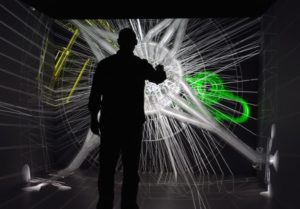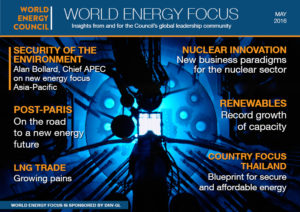
In the U.S. and Canada more than three dozen firms, representing about $1.3 billion in impatient investor money, are currently pursuing technological innovations in nuclear energy. These firms include large, big-name projects, with deep pockets, like TerraPower, and small startups like Terrestrial Energy. All of them are placing their chips on a comeback for nuclear energy driven by the need to decarbonize the generation of electricity needed to power the global economy.
The involvement of these new investors signals a profound shift taking place from government-led, and funded, nuclear R&D to private sector-led efforts by people with strong entrepreneurial goals, often linked to a social purpose. They want to make money from their inventions, but they also want to see nuclear energy used in place of fossil fuel power stations to curb CO2 emissions.
So far most of the global spending internationally on advanced nuclear R&D has been taking place under the umbrella of the GEN IV program which centers on six advanced reactor types. Most of this work has been housed at various national laboratories functioning as sandboxes for scientists. By contrast, the business model the new developers have adopted comes out of the Silicon Valley model of development. The idea is to pull together a small team of world class experts to create new technological advances that can find acceptance in the market.
However, unlike the Silicon Valley model, developing a new nuclear reactor design is not a one-to-two year rush similar to creating a new computer chip, mobile device, or platform for software as a service. For example, even the timescale for the development of a small modular reactor like NuScale’s 50MW one, is in the range of 10-15 years, even though it is based on mature light-water reactor technology. It is still a question of how much patience investors will have for a much longer time to market.
One solution companies are pursuing is to form partnerships with public institutions that will give them access to the expertise – and the high-powered computers and simulation software – to solve difficult engineering design problems. Todd Allen, former deputy director of Idaho National Laboratory, and visiting fellow at the Washington D.C. based think tank The Third Way , believes that such public-private partnerships are the key to success for the new breed of nuclear energy entrepreneurs. He notes that there are different types or arrangements being pursued from cost-sharing funding from the U.S. Department of Energy (DOE) to cooperative R&D agreements with national laboratories, universities, major nuclear reactor vendors, and not-for-profit technology labs and think tanks.
In a white paper recently posted on the Third Way web site, Allen and his colleagues write that the nuclear energy industry “must adapt” to create a “culture of innovation” which will accommodate a new “range of new nuclear technologies of varying size and purpose.” The federal government needs to share the road with nuclear innovators because it is no longer the only source of new ideas. “Today technology is developed through competition of ideas from many companies and institutions”, notes the report.
Public-private partnerships, and the creation of federally funded “innovation centers,” are especially effective, Allen says, because they help give private actors gain access to materials testing facilities, and in developing and testing new nuclear fuels for innovative reactors.
Allen says the government’s efforts are moving in the right direction. As an example he cites the recent site permit granted by DOE to NuScale and a consortium of utilities in the western U.S. to build up to twelve 50MW small modular reactors on the site of Idaho National Laboratory.

Another promising initiative, called the Gateway for Accelerated Innovation In Nuclear (GAIN) was announced at a Third Way sponsored nuclear summit held in Washington, D.C., in January. Its primary objectives are to provide nuclear innovators with the technical, regulatory, and financial support necessary to move new nuclear reactor designs towards commercialisation. Led by Idaho National Laboratory, in partnership with Argonne National Laboratory and Oak Ridge National Laboratory, GAIN will work to integrate and facilitate efforts by private industry, universities, and national labs to develop, test, and demonstrate innovative nuclear technologies and to accelerate the licensing and commercialisation of these systems.
Additionally, the Obama administration has opened a $12.5 billion loan guarantee programme for advanced nuclear technology projects including covering the costs of design certification by the U.S. Nuclear Regulatory Commission (NRC).
So what innovations are out there? A report on innovative nuclear reactor designs published in June 2015 by the Third Way lists five major advanced design types with several variations for each of them. These include small modular reactors of the light water type, and more advanced types such as molten salt reactors, liquid-cooled metal (sodium, lead-bismuth) reactors, high temperature gas-cooled reactors using helium, and thorium-fueled reactors.
Two very different U.S. companies that are committed to bringing new reactors to the market are Terrestrial Energy and TerraPower. Terrestrial Energy, a small startup, is developing an Integral Molten Salt Reactor (IMSR) in Canada. Its key design feature is that the coolant is also the fuel so the reactor cannot melt down. The firm says the design will be ready for commercial customers within the next decade.
According to CEO Simon Irish, the IMSR represents a completely new paradigm for civilian nuclear energy. He calls it a “cost-competitive, scalable, grid-independent energy source” and touts its innovations in terms of safety and proliferation resistance. Customers could include remote communities, such as those in the far northern provinces of Canada or island nations in the vast Pacific ocean. Other potential customers include factories for ammonia, fertilizer and hydrogen production, mining operations, petroleum refining, and desalinization to name a few.
So far the firm has start-up funding commitments for $10 million and another for $5 million. Given that success to complete the design will require a greats deal more money, CEO Irish says that what keeps him awake at night are disturbances in the policy environment among governments for support of innovative nuclear technologies. “The biggest challenge we all face is that today’s market and policy realities disadvantage all baseload technologies. Ten times more tax-payer’s dollars in 2015 flowed into support renewables compared to nuclear. By comparison, nuclear energy provides two-thirds of current clean power. History clearly shows it can provide close to 100%.”
On the other side of the innovation spectrum, TerraPower, supported by the Bill Gates foundation, has developed the 1150 MW traveling wave reactor (TWR). It uses liquid metal sodium as a coolant and depleted uranium as a fuel. Like the IMSR, the reactor’s fuel cannot be used to make materials for atomic bombs.
In September 2015 TerraPower inked a deal with the China National Nuclear Corporation (CNNC) to build a half-size, first-of-a-kind unit in China. Once testing of the prototype is complete, the two firms will collaborate to build and export full-size units for customers worldwide. The timeline is that the prototype will be completed between 2018 and 2023 and the commercial units come to market within the next 15 years. It is plausible that some U.S. firms could be part of the supply chain for the exported reactors.
According to John Gilleland, Chief Technical Officer of Terrapower, when the firm first got started about ten years ago, its founders were not sure that the technical concepts they were investing in could be taken the distance to a complete design much less a prototype. To achieve its objectives the company worked with the Department of Energy’s national laboratories and several dozen other commercial and research centers. Its ability to leverage public-private partnerships was crucial for the company to get access to computer modeling and simulation capabilities, says Gilleland.
David Hess, an analyst for the World Nuclear Association, says that of the advanced nuclear concepts being developed, the advantage of small modular reactors (SMRs) is that “they present lower barriers to entry for emerging countries. The small size of SMRs also makes them suitable for use in smaller networks or places where demand is flat or growing slowly. They could also be used for the incremental replacement of smaller fossil units."
SMRs will be easier to finance even if the cost per kilowatt isn’t initially much different than larger light water units, says Hess. At 50MW, a unit might cost $200 million assuming a cost of $4,000/kW.
For major nuclear powers like Russia and China, fast reactors are central to their long-term nuclear energy plans. The advantage of these reactors is that they are able to reprocess spent fuel from commercial reactors and depleted uranium from enrichment plants. By putting this material back into useful nuclear fuel, the volume of material that has to be sent to be stored at the reactor or in an interim storage facility is reduced.
“These advanced designs can dramatically increase the useful nuclear fuel resource and offer a way to reduce the existing volumes of used fuel, including depleted uranium from enrichment plants, which might otherwise be disposed of as radioactive waste”, says Hess.
According to the World Nuclear Association, fast neutron reactors are more than just concepts. Many countries have built and operated fast reactors in the past with mixed degrees of success. Hess notes that “Russia connected a new 790MW fast reactor to the grid late last year. There are a huge number of potential configurations to a fast reactor.”
He feels there are “reasons to be confident that one or more will be found which overcome the technical problems of earlier designs and offer economics comparable to non-fast reactor alternatives.”
So far the emphasis has been with state-owned corporations like those in China with their work on high temperature gas cooled reactors that use pebble bed fuel enrichment with helium coolant. Russia has reported progress in its work on the sodium cooled BN-600 and 800 fast reactors, and has committed the money to take these design concepts, and the fuel to burn in them, to the working prototype stage.
In the U.S. the Next Generation Nuclear Plant Alliance (NGNP), a business consortium, selected a conceptual design developed by Areva for a high temperature gas cooled reactor. The first prototype could be built in the mid-2020s at a cost of $2.3 billion. According the Alliance, the plant would be competitive with $6 to $10/MMBtu natural gas. Currently, gas is cheaper – but oil and gas prices are notoriously volatile. Nuclear power, if it manages to adjust itself to changing market conditions, still has a long future ahead of it.
ENDS
To read the full May 2016 issue, register at www.worldenergyfocus.org - it's free.
Interview Alan Bollard, Executive Director APEC: “It’s all about sustainable growth”

News Focus
Post-Paris: the world is starting on a new energy road
Record growth renewable energy capacity
Global LNG trade up
News in Brief
Country Focus
Thailand’s blueprint for secure and affordable energy
Events





